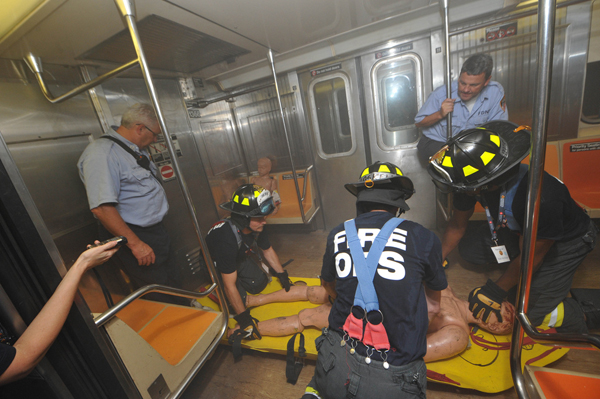CITY VIEWS: OPINIONS and ANALYSIS
Firefighter for a Day
Jarrett Murphy |
After months reporting a story on the FDNY, all it took was three steps into a smoky room for this reporter to realize how much he didn’t know.

The author (left) and teammates Peter Haskell of CBS News Radio (center) and Mark McMillan from the Queens Borough President's office, rescue a victim of a subway bombing during a Fire Ops 101 drill.
After months reporting a story on the FDNY, all it took was three steps into a smoky room for this reporter to realize how much he didn’t know.
A City Limits investigation looked at FDNY fatalities over 20 years, finding common factors and tracking the city’s efforts to address them.
Serious problems with the emergency response on 9/11 contributed to the loss of rescuer lives. A decade later, FDNY counts itself much better prepared. But some questions remain.
Two fires 10 years apart at one high-rise in the Rockaways helped convince the FDNY to reconsider its time-honored tactics when dealing with wind-driven fires.
Each of the FDNY’s line-of-duty deaths over the past 20 years involved a unique person and unique circumstances. But according to investigations by the FDNY and the National Institute for Occupational Safety and Health, common contributing factors link many of the incidents.
The FDNY is committed to “aggressive, interior firefighting.” When that’s the plan, equipment, training and manpower are all less important that human decision-making.
From the 9-11 Commission to reports on individual firefighter tragedies, check out these links to learn more about the FDNY and firefighter fatalities.
Heart attacks are the single largest threat to firefighters’ lives, with everything from stress to heat to noise at fire scenes elevating the risk factors.
Problems with the performance of the 911 system on Sept. 11 led the Bloomberg administration to undertake a four-pronged emergency communications transformation program
The upcoming firefighters’ test represents the latest attempt in a 40-year effort to try to diversify the mostly white, overwhelmingly male FDNY.